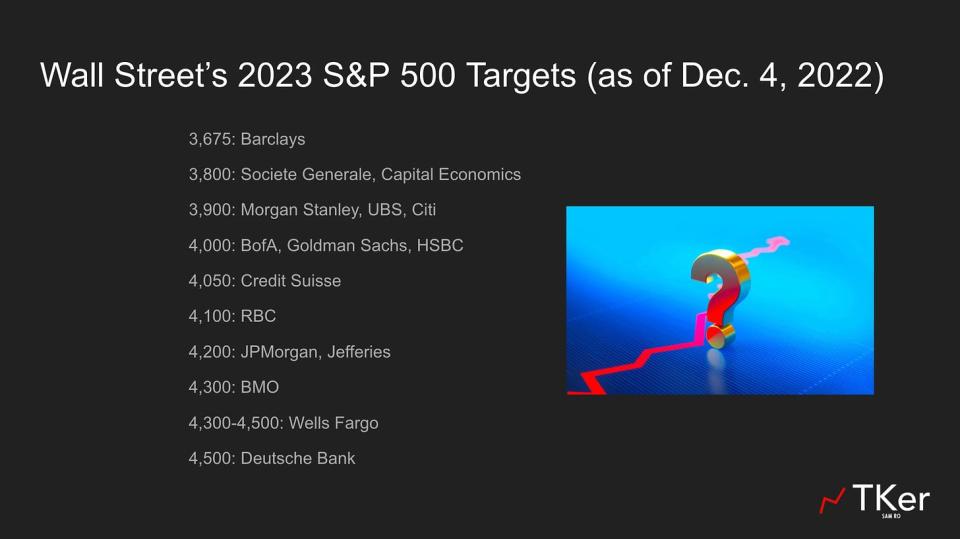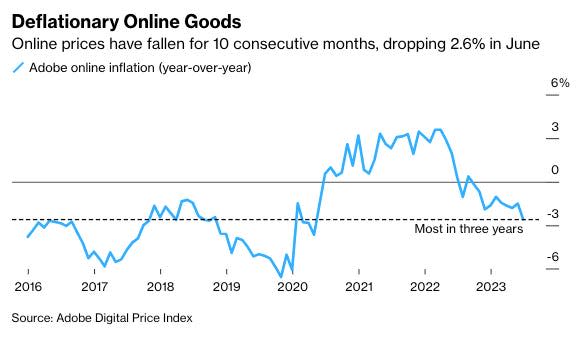A version of this post first appeared on TKer.co
Stocks climbed last week with the S&P 500 jumping 2.4% to close at 4,505.42. The index is now up 17.3% year to date, up 26% from its October 12 closing low of 3,577.03, and down 6% from its January 3, 2022 record closing high of 4,796.56.
Before dipping slightly on Friday, the S&P closed Thursday at 4,510.04, the highest level since April 2022.
It’s worth noting the S&P is now above all the year-end targets Wall Street forecasters had coming into the year.
This speaks to how difficult it is to predict short-term moves in the market when the most well-resourced, full-time professionals at the highest tier of the industry find themselves on their heels.

What’s been driving the rally?
Well, resilient economic growth and the improving outlook for activity helps.
Cooling inflation and a Federal Reserve that’s getting less hawkish also helps.
Importantly, the improving outlook for earnings certainly helps.
“If earnings recover as the consensus expects, and if we do get a soft landing, then it's possible stocks could be on the road to new highs,” Jurrien Timmer, director of global macro at Fidelity, wrote on Wednesday.
“Currently, the consensus estimate is that S&P earnings will contract by 9% in the second quarter and then bottom in the third quarter of this year, before recovering in 2024,” he added. “If that is correct, then the rise in stocks and increase in P/Es that we have seen since last October could be justified and could continue.”
Indeed, we are in the midst of a widely anticipated mild earnings recession. But as stocks are wont to do, they appear to be pricing in the future more so than the present or past.
Nevertheless, the sentiment among Wall Street’s stock market forecasters is anything but frothy.
Even though many Wall Street strategists have revised up their 2023 targets for the S&P 500, many expect the index to end lower by the end of the year. According to Bloomberg, the average strategist’s target implies a 6.6% decline in the S&P during the second half of the year.
Who knows what stocks do in the coming months? Maybe they go up. Maybe they go down.
We do know that the outlook for earnings growth in the coming years is bullish. So it wouldn’t be too surprising if stocks end up even higher a year or two from now. This would be consistent with the long history of how earnings trend and how stocks move with those earnings.
The market spends much more time going up than down. If history tells us one thing about the difference between the bulls and the bears, it’s that the bulls are usually right
Reviewing the macro crosscurrents 🔀
There were a few notable data points and macroeconomic developments from last week to consider:
🇺🇸 The state of the economy according to the top banker. From JPMorgan CEO Jamie Dimon: “The U.S. economy continues to be resilient. Consumer balance sheets remain healthy, and consumers are spending, albeit a little more slowly. Labor markets have softened somewhat, but job growth remains strong. That being said, there are still salient risks in the immediate view — many of which I have written about over the past year.
Consumers are slowly using up their cash buffers, core inflation has been stubbornly high (increasing the risk that interest rates go higher, and stay higher for longer), quantitative tightening of this scale has never occurred, fiscal deficits are large, and the war in Ukraine continues, which in addition to the huge humanitarian crisis for Ukrainians, has large potential effects on geopolitics and the global economy.”
🎶 Taylor Swift’s economic impact gets the attention of the Fed. The Federal Reserve’s July Beige Book of economic anecdotes concluded: “Overall economic activity increased slightly since late May.” It also observed something interesting in the Philadelphia area: “Despite the slowing recovery in tourism in the region overall, one contact highlighted that May was the strongest month for hotel revenue in Philadelphia since the onset of the pandemic, in large part due to an influx of guests for the Taylor Swift concerts in the city.”
🎈 Inflation cools. The Consumer Price Index (CPI) in June was up 3.0% from a year ago, the lowest level since March 2021. Adjusted for food and energy prices, core CPI was up 4.8%, the lowest since October 2021.

On a month-over-month basis, CPI was up 0.2%. Core CPI was up 0.2%, the lowest level since August 2021.

If you annualize the three-month trend in the monthly figures, CPI is rising at a 2.2% rate and core CPI is climbing at a 3.5% rate.

The bottom line is that while inflation rates have been trending lower, many measures continue to be above the Federal Reserve’s target rate of 2%.
🤷🏻♂️ Consumers’ outlook for inflation eases. From the New York Fed’s June Survey of Consumer Expectations: “Median inflation expectations declined for the third consecutive month at the one-year-ahead horizon from 4.1% in May to 3.8% in June, the lowest reading since April 2021. The measure has now fallen by 3 percentage points from its series high in June 2022. The decline is broad based across demographic groups. In contrast, median inflation expectations remained unchanged at 3.0% at the three-year-ahead horizon and increased by 0.3 percentage point to 3.0% at the five-year-ahead horizon, the highest reading since March 2022.”

📉 Online prices are falling. From Bloomberg: “Prices of goods sold online fell 2.6% in June from a year earlier, according to data from Adobe Inc. released Tuesday. It was the biggest drop since May 2020, and the 10th straight month in which there’s been a year-on-year decline. More than half of the 18 main categories tracked by Adobe showed prices falling on an annual basis.”

👍 Wage growth is outpacing inflation. From Axios: “Real average hourly earnings are up 1.2% in the 12 months ended in June, the Labor Department said Wednesday following the release of the latest inflation data. It had ticked higher in May, but before that had been in negative territory for nearly two years, as workers' raises were not enough to keep up with sky-high inflation. For production and nonsupervisory workers, that number was even stronger, with a 2.2% year-over-year gain in real average hourly earnings.”
💳 Consumers are spending. Here’s Renaissance Macro Research on BEA data: “Auto sales are likely to pick-up in July, but on top of this, weekly data on consumer spending based on payment card transactions are running strong. For the week July 4, spending ran +14.9% against the pre-pandemic baseline. The four-week moving average has been steady, ~10%.”
💼 Unemployment claims tick down. Initial claims for unemployment benefits fell to 237,000 during the week ending July 8, down from 248,000 the week prior. While this is up from the September low of 182,000, it continues to trend at levels associated with economic growth.

👍 Consumer sentiment jumps. From the University of Michigan’s July Survey of Consumers: “Consumer sentiment rose for the second straight month, soaring 13% above June and reaching its most favorable reading since September 2021. All components of the index improved considerably, led by a 19% surge in long-term business conditions and 16% increase in short-run business conditions. Overall, sentiment climbed for all demographic groups except for lower-income consumers. The sharp rise in sentiment was largely attributable to the continued slowdown in inflation along with stability in labor markets.”

👍 Small business sentiment ticks up. The NFIB’s Small Business Optimism Index (via Notes) improved in June.

A key driver of the uptick in optimism was the improved outlook toward the economy. From the NFIB: “It does look like the economy is slowing down, but 'data' are not recessionary – except for the leading indicators which continue to get more negative. So where is the recession hiding? Housing seems to have bottomed and is moving up modestly, consumer spending is flat but not headed for the exits, credit statistics are flashing some problems but not critical, there are some large city real estate problems, but not widespread…”

As the NFIB shows, the more tangible “hard” components of the index have held up much better than the more sentiment-oriented “soft” components.

Keep in mind that during times of stress, soft data tends to be more exaggerated than actual hard data.
📈 Inventory levels are up. According to Census Bureau data released Tuesday, wholesale inventories stood at $913.7 billion in May. The inventories/sales ratio was 1.41, up significantly from 1.30 the previous year.

📈 Near-term GDP growth estimates remain positive. The Atlanta Fed’s GDPNow model sees real GDP growth climbing at a 2.3% rate in Q2. While the model’s estimate is off its high, it’s nevertheless very positive and up from its initial estimate of 1.7% growth as of April 28.
Putting it all together 🤔
We continue to get evidence that we could see a bullish “Goldilocks” soft landing scenario where inflation cools to manageable levels without the economy having to sink into recession.
The Federal Reserve recently adopted a less hawkish tone, acknowledging on February 1 that “for the first time that the disinflationary process has started.“ On May 3, the Fed signaled that the end of interest rate hikes may be here. And at its June 14 policy meeting, it kept rates unchanged, ending a streak of 10 consecutive rate hikes.
In any case, inflation still has to come down more before the Fed is comfortable with price levels. So we should expect the central bank to keep monetary policy tight, which means we should be prepared for tight financial conditions (e.g. higher interest rates, tighter lending standards, and lower stock valuations) to linger.
All of this means monetary policy will be unfriendly to markets for the time being, and the risk the economy sinks into a recession will be relatively elevated.
At the same time, we also know that stocks are discounting mechanisms, meaning that prices will have bottomed before the Fed signals a major dovish turn in monetary policy.
Also, it’s important to remember that while recession risks may be elevated, consumers are coming from a very strong financial position. Unemployed people are getting jobs. Those with jobs are getting raises. And many still have excess savings to tap into. Indeed, strong spending data confirms this financial resilience. So it’s too early to sound the alarm from a consumption perspective.
At this point, any downturn is unlikely to turn into economic calamity given that the financial health of consumers and businesses remains very strong.
And as always, long-term investors should remember that recessions and bear markets are just part of the deal when you enter the stock market with the aim of generating long-term returns. While markets have had a pretty rough couple of years, the long-run outlook for stocks remains positive.
A version of this post first appeared on TKer.co
"stock" - Google News
July 16, 2023 at 11:40PM
https://ift.tt/QfltjGL
The sentiment among Wall Street’s stock market forecasters is anything but frothy - Yahoo Finance
"stock" - Google News
https://ift.tt/GPJtxM5
https://ift.tt/FYG8vnK
Bagikan Berita Ini














0 Response to "The sentiment among Wall Street’s stock market forecasters is anything but frothy - Yahoo Finance"
Post a Comment